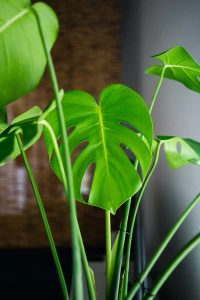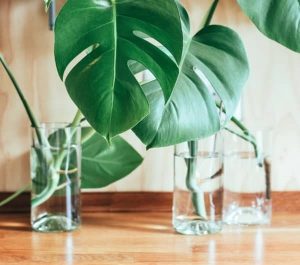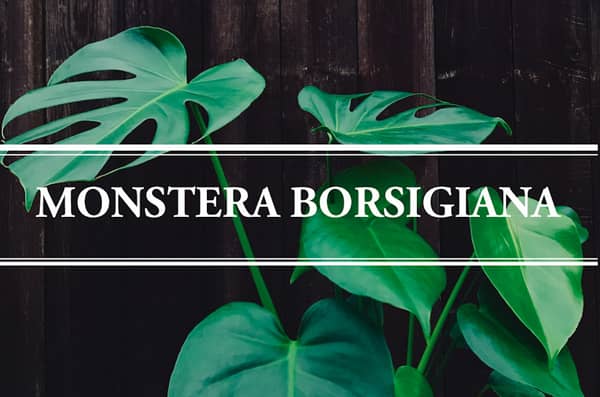Let us get to know another popular Monstera plant, the Monstera borsigiana. It is basically a sub-species of the famous Monstera deliciosa. The basic difference between the two is the smaller plant size and faster-growing speed of the Borsigiana. Moreover, these sub-species readily form variegations that are strong enough to be passed on in propagations. The juvenile dark-green heart-shaped leaves develop the typical Monstera perforations on maturity.
This creeper carries the Monstera creeping legacy and can grow both indoors and outdoors. You can make beautiful hanging baskets and pots with this plant. So, if you are a fan of low-maintenance plants with perforated leaves, this is just a perfect choice for you. Let us know more about the care and maintenance of the Monstera deliciosa borsigiana plant.
Monstera Borsigiana Classification
Family: Araceae.
Genus: Monstera.
Species: M. deliciosa.
Sub-specie: Borsigiana.
To understand the sub-specie better, let us have a look at the Monstera Deliciosa plant.
Monstera Deliciosa
This South Mexican native is one of the 48 flowering species of the genus. The name Deliciosa is given due to the unique and tasty fruit it produces. The green heart-shaped leaves can get as bigger as 50 cm and develop deep perforations on maturity.
Moreover, they get even bigger in their natural outdoor growth habitat. It can grow well both indoor and outdoor. This creeper climbs upon the supports with the help of aerial roots.
Monstera Borsigiana Common Names
- Monstera deliciosa ‘wrinkle’.
- Wrinkle Deliciosa.
Monstera Borsigiana Plant Features

Height and Structure
- The size of the plant is variable and dependant upon the growing habitat. An average indoor plant remains under 2 meter on maturity. However, these plants grow taller in outdoor habitat.
- These plants are climbers by nature. Use a support like a pole of sphagnum moss to provide support to the potted plant.
Flowers
- Small and non-showy plants grow on the plant in the season of spring and summer. However, blooming is rare, especially in indoor growers.
Toxicity
Monstera deliciosa borsigiana carries the typical legacy of toxicity. It is dangerous for both humans and animals. Thus, keep the kids and pets away from the plant.
Variegated Monstera Borsigiana
Now, let us have a look at one of the most in-demand variegated plants lately. The white portions in the leaves are due to the lack of chlorophyll. The phenomenon behind this phenomenal plant is known as chimeral variegation caused by a genetic mutation.
Is your variegated monstera albo borsigiana growing a full green leaf? You can simply cut the new green leaf up till the variegation. This will help to prolong the variegation. It is important to mentions here that the variegated leaves have a smaller life span. The reason behind this is the lack of food forming chlorophyll causing lesser nutrition.
Finally, coming towards the Monstera bonsigiana albo Care. It is easy to keep the plant pretty suitable for beginners. The basic care and requirements are similar to the Borsigiana, as explained in the next section.
Monstera Borsigiana Care
The basic requirement of the plant includes deep watering, warmth and indirect light. Let us know the requirements in detail.
Water Requirement
The plant dwells on a simple watering strategy. Water the soil generously and wait for the upper layer of the soil to get dry. As far as frequency is concerned, once or twice a week in summer will be enough. While in winter, one deep watering will suffice the plan for a whole one week or more.
Now, what is the proper Monstera watering? It means a thorough watering until the water comes out of the drainage holes. After that, let the upper 2 inches of the soil get about 70% dry before you water again. It is important to mention here that Monsteras hate overwatering. Thus, make sure you avoid making the plant stay in standing water or soggy soil.
Sunlight Requirement
Just find a spot will plenty of indirect light to keep this plant. Direct light is harmful to these delicate peeps.
Temperature Requirement
The optimum temperature range for the plant is between 15 to 25 °C. Winter and frost don’t show a healthy effect on the plant. Thus, don’t forget to shift your Wrinkle Monstera to a warmer spot before the autumn strikes.
Soil Requirement
Choose any house plant growing mix with large particles and quick-drying ability. The ideal PH range is between 5 to 7.5.
Humidity Requirement
These dwellers of tropical areas love high humidity. A moisture level of around 70% is necessary to keep the plant happy. In dry days, you need to fix the moisture content of the air. You can use a pebble-water tray under the pot or introduce a humidifier in the surroundings.
Fertilizer Requirement
A common house plant fertilizer is good for the plant’s health. You can use a monthly dose of mild or diluted fertilizer in the growing season. On the other hand, cold days reduce the nutritional requirements of the plants. Thus, avoid fertilizing after the autumn until the weather gets pleasant in spring.
Pot and Repotting Requirement
Choose a big pot with drainage holes at the base. These climbers need support to climb upon. You can use a natural sphagnum moss pole and insert it in the soil to ensure proper growth. Frequent repotting is not a nice idea for these Monsteras. Let the plant stay in the pot until it gets root bounds.
Cutting and Trimming Requirements
This avid grower needs a regular cut to be in shape. Cut and remove few branches or the older leaves from the plant. This will help you to maintain the size, appearance, and health of your Monstera.
Place Requirements
Like many other Monsteras, the perforated leaves are too delicate to face the drifts. Keep them away from the direct pressure of air-conditioners, heaters and drifty windows.
Growth Zones
Ideal USDA growth zones are 9b to 11. In these zones, the plants can easily grow outdoors without any hassle.
Related Posts:
M.deliciosa thai constellation
Monstera Borsigiana Propagation

Monsteras are generally easy to propagate. You can use stem-top cuttings or propagate them by air-layering. The ideal period for making new monsteras is the warm days of spring until the middle of the summer.
Propagation by stem-tip cutting
Let us get to know the process in two steps.
Rooting the cuttings
- Cut 10 to 15 inches stem from the upper growing part. The cutting must have at least two aerial roots. These roots help the plant develop in the rooting system.
- Fill a container with water. If you are using tap water, just let it stay overnight. It will help the chlorine to settle down.
- Dip the cuttings in the water while dipping the node inside. Place the setup in some warm place with bright indirect light.
- Keep an eye on the water and change it weekly to avoid letting it get mucky.
- You will see the development of roots in a period of about 3 to 4 weeks.
Planting the Rooted Cuttings in Soil
- Fill the pot with suitable growing mixture and water it mildly.
- Now, plant the rooted cuttings and firm the soil around.
- The baby plants need to be in a warm spot with indirect sunlight.
- Keep watering the soil about twice a week after the upper layer of the soil gets about 70%dry.
- The baby plant will develop tiny shoots after a period of about 5 to 7 weeks.
Congratulations! You have successfully made a new Monstera. Enjoy further development and take care of the plant as mentioned in the previous section.
Summary
Monstera borsigiana is a sub-specie of the famous plant monster deliciosa. It is smaller in size and has a rapid growth rate as compared to the Deliciosa. The dark-green heart-shaped leaves grow to get holes turning into typical Monstera perforations on maturity.
The Borsiginia plant commonly gets variegation to make the beautiful Variegated Monstera borsigiana plant. These low-maintenance peeps need warmth with medium to bright indirect light. Water the soil generously right after the upper layer of soil gets dry.
You can select these plants to decorate any indoor corner. Importantly, the Monstera legacy of toxicity makes the ingestion toxic for both kids and pets. Just make sure you keep them away from kids and pets.

